As the month of December 1941 began, Billboard magazine’s no. 1 song was “Chattanooga Choo Choo” by the Glenn Miller Orchestra, featuring Fort Worth’s Tex Beneke. Best-selling books included Curious George and Little Town on the Prairie. Popular radio programs included “The Adventures of the Thin Man,” “The Great Gildersleeve,” and “Songs by Dinah Shore.”
A look through the inside pages of the Star-Telegram on December 1 showed:
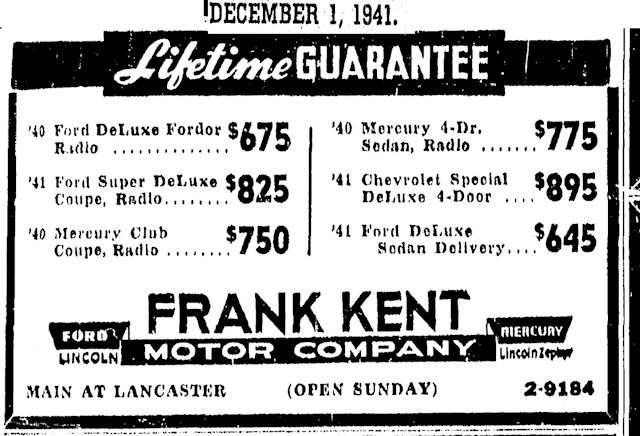 Ford dealer Frank Kent would sell you a 1941 Ford Super DeLuxe coupe for $825 ($14,500 today).
Ford dealer Frank Kent would sell you a 1941 Ford Super DeLuxe coupe for $825 ($14,500 today).
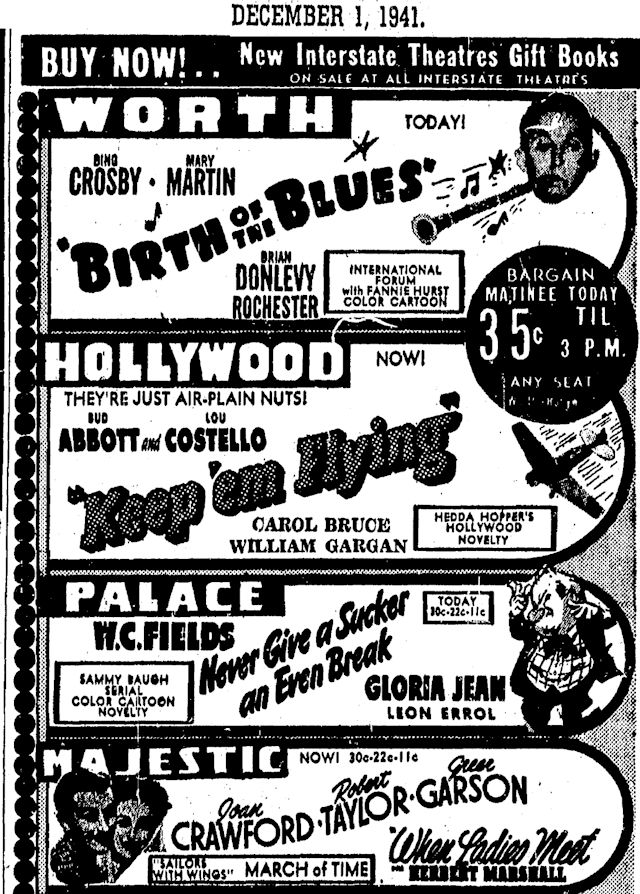 The stars were shining downtown at the Hollywood, Worth, Majestic, and Palace theaters of the Interstate chain. Note Weatherford’s Mary Martin at the Worth and TCU’s Sammy Baugh at the Palace. Baugh had played football for TCU in the 1930s. By 1941 he was playing for the Washington Redskins.
The stars were shining downtown at the Hollywood, Worth, Majestic, and Palace theaters of the Interstate chain. Note Weatherford’s Mary Martin at the Worth and TCU’s Sammy Baugh at the Palace. Baugh had played football for TCU in the 1930s. By 1941 he was playing for the Washington Redskins.
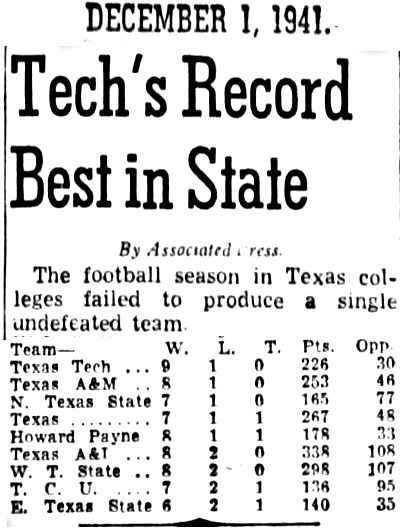 In football TCU had a 7-2-1 record.
In football TCU had a 7-2-1 record.
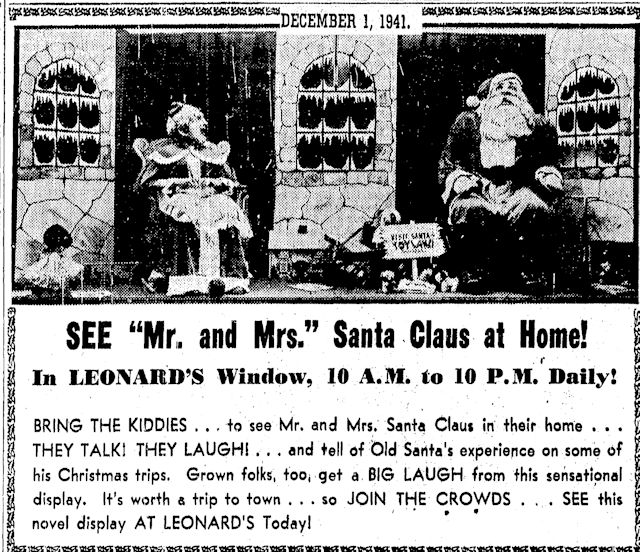 At Leonard’s Department Store “kiddies” and “grown folks, too” could see Mr. and Mrs. Santa Claus in their home.
At Leonard’s Department Store “kiddies” and “grown folks, too” could see Mr. and Mrs. Santa Claus in their home.
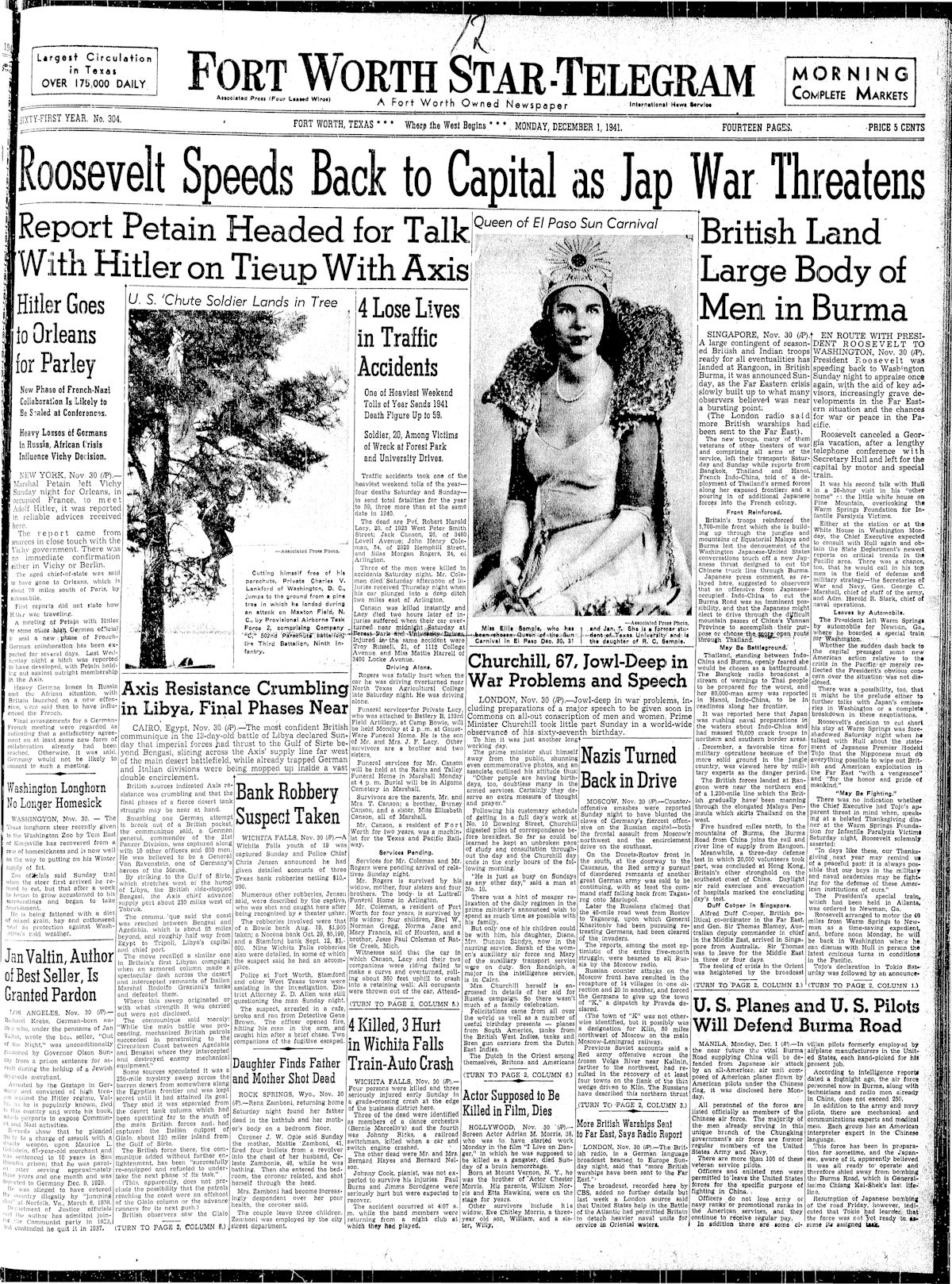 Yes, the inside pages of the newspaper were full of entertainment and bargains, but the front page was another story—a story of geopolitical tension.
Yes, the inside pages of the newspaper were full of entertainment and bargains, but the front page was another story—a story of geopolitical tension.
“Jap War Threatens,” read the banner headline of December 1.
In 1937 Japan had declared war on China, hoping to expand into Chinese territory and take over China’s import market.
The United States responded with economic sanctions and trade embargoes against Japan, hoping to starve Japan of money and goods, especially essential supplies like the oil needed to power its expansionism.
Instead, the sanctions made Japan more recalcitrant. Months of negotiations between Tokyo and Washington produced scant progress.
When World War II had begun in Europe in 1939, America had remained neutral, just as it had when World War I began. But by December 1941 Japan presented a military threat in southeast Asia and the Pacific Ocean to territories of England, the Netherlands, and the United States (Hawaii, Philippines, Guam, Wake Island).
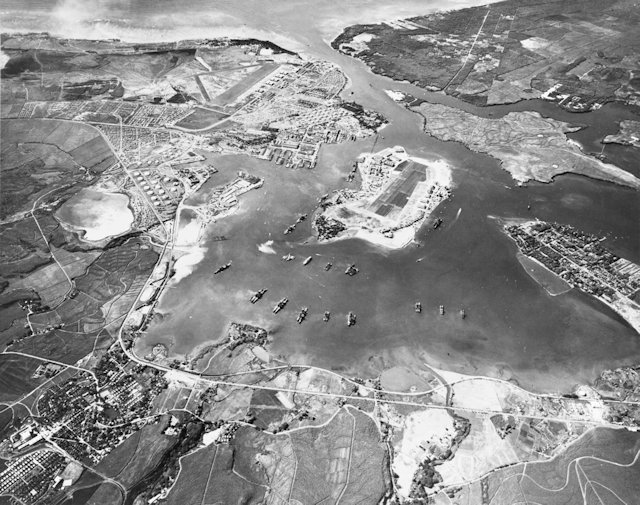 The U.S. Navy maintained a high profile in the Pacific. Much of the Navy’s fleet was based at Pearl Harbor, Hawaii. This photo taken in October 1941 shows U.S warships anchored near the harbor’s Ford Island. (Photo from Wikipedia.)
The U.S. Navy maintained a high profile in the Pacific. Much of the Navy’s fleet was based at Pearl Harbor, Hawaii. This photo taken in October 1941 shows U.S warships anchored near the harbor’s Ford Island. (Photo from Wikipedia.)
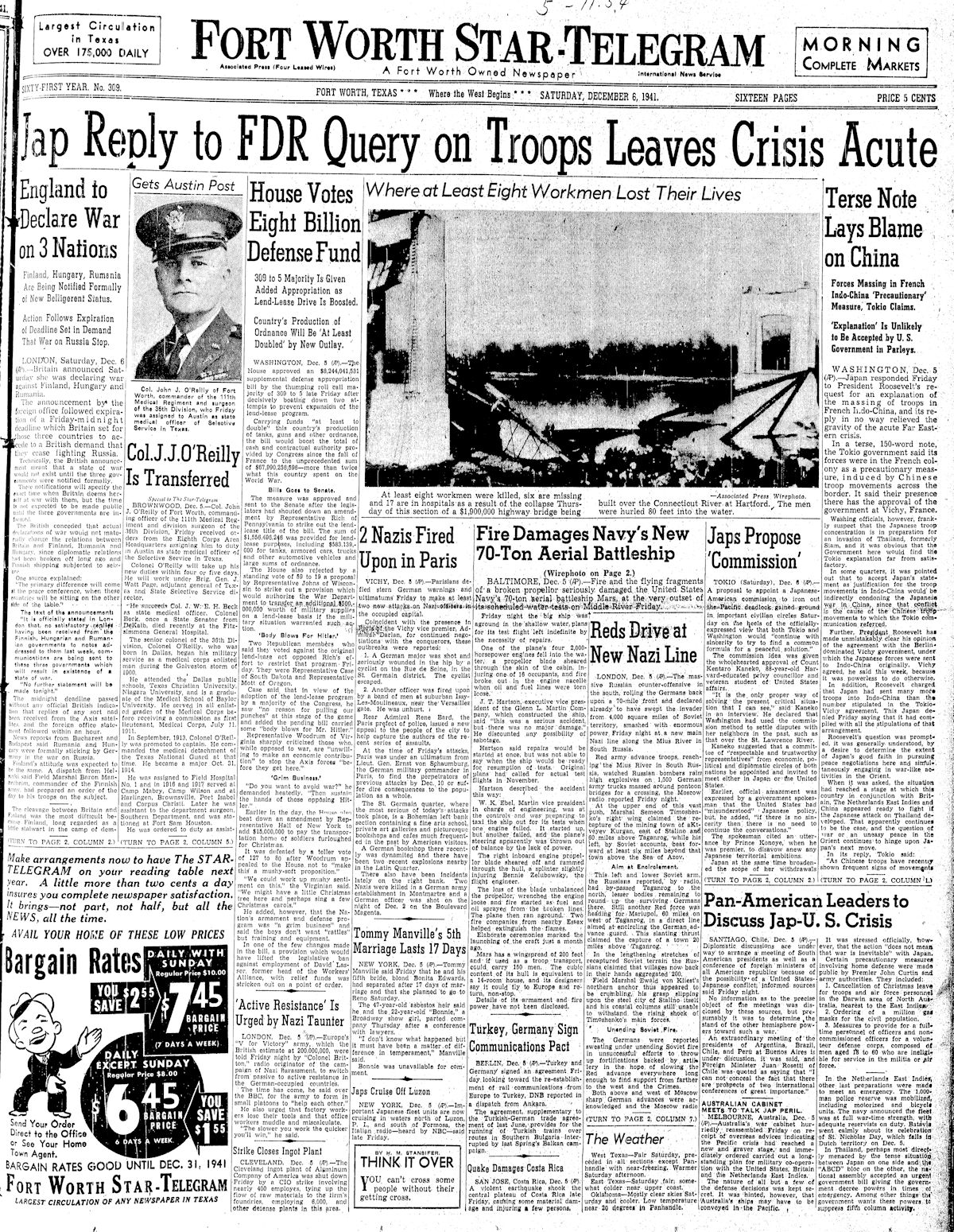
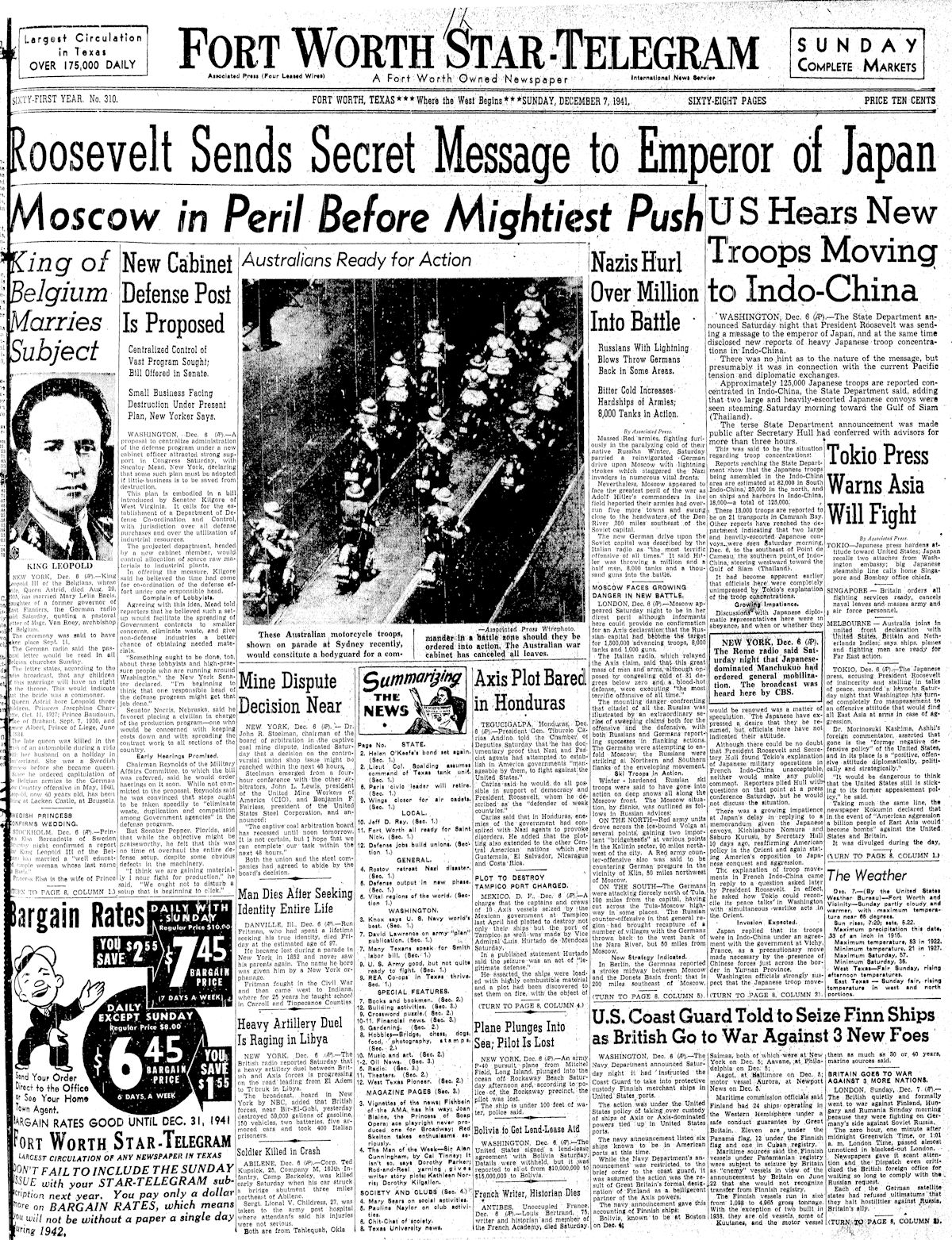
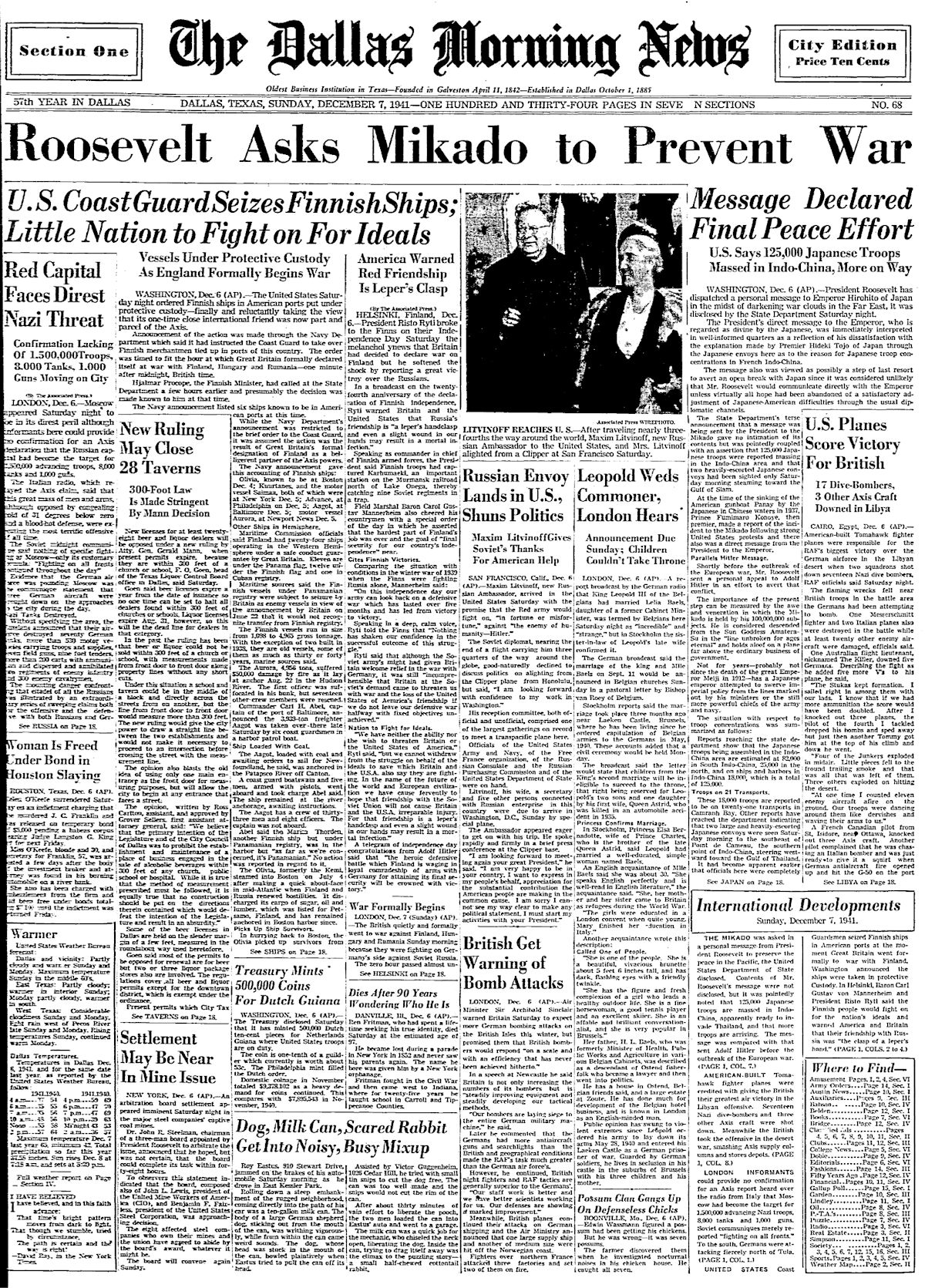 As the first week of December 1941 wore on, diplomacy edged toward desperation. (The “Mikado” was Emperor Hirohito of Japan.)
As the first week of December 1941 wore on, diplomacy edged toward desperation. (The “Mikado” was Emperor Hirohito of Japan.)
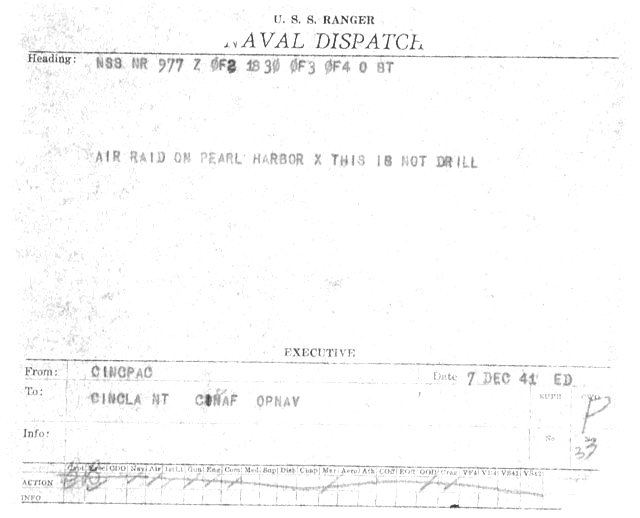 Then, on the morning of December 7 the U.S. commander in chief, Pacific (CINCPAC) sent this terse dispatch to the commander in chief, Atlantic (CINCLANT): “AIR RAID ON PEARL HARBOR X THIS IS NOT DRILL.” (Image from the John J. Ballentine Papers.)
Then, on the morning of December 7 the U.S. commander in chief, Pacific (CINCPAC) sent this terse dispatch to the commander in chief, Atlantic (CINCLANT): “AIR RAID ON PEARL HARBOR X THIS IS NOT DRILL.” (Image from the John J. Ballentine Papers.)
The “air raid” began at 7:48 a.m. Hawaiian time. The U.S. naval base at Pearl Harbor was attacked by 353 Japanese aircraft launched from six aircraft carriers.
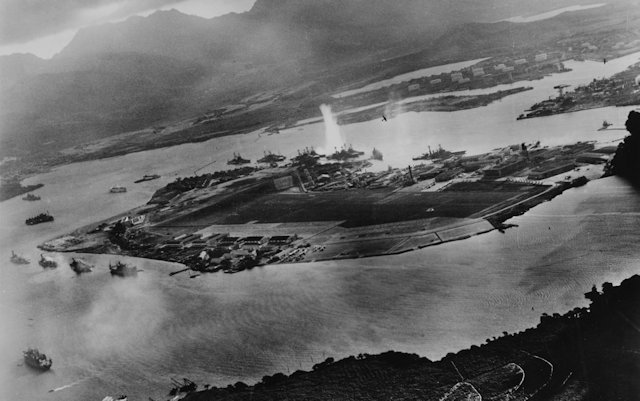
This photograph was taken from a Japanese warplane over Pearl Harbor just after the attack began. A torpedo had just hit the USS West Virginia on the far side of Ford Island (center). Japanese planes are visible in the right center (over Ford Island) and over the Navy yard at right. (Photo from Wikipedia.)
The American toll:
8 battleships damaged
4 battleships destroyed
3 cruisers destroyed
3 destroyers destroyed
188 aircraft destroyed
2,403 Americans killed
1,178 Americans wounded
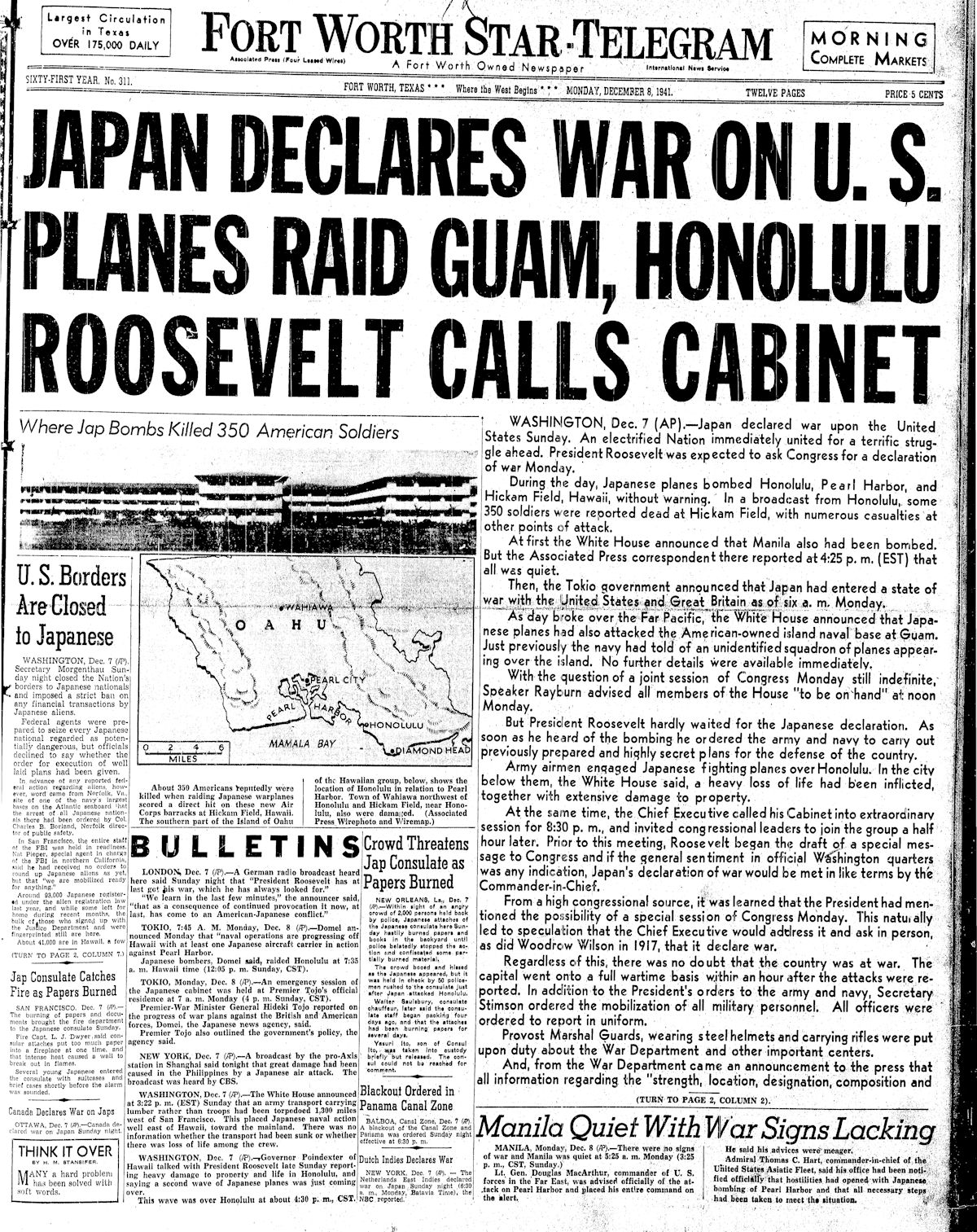
 The front pages of the Star-Telegram and Dallas Morning News on December 8.
The front pages of the Star-Telegram and Dallas Morning News on December 8.
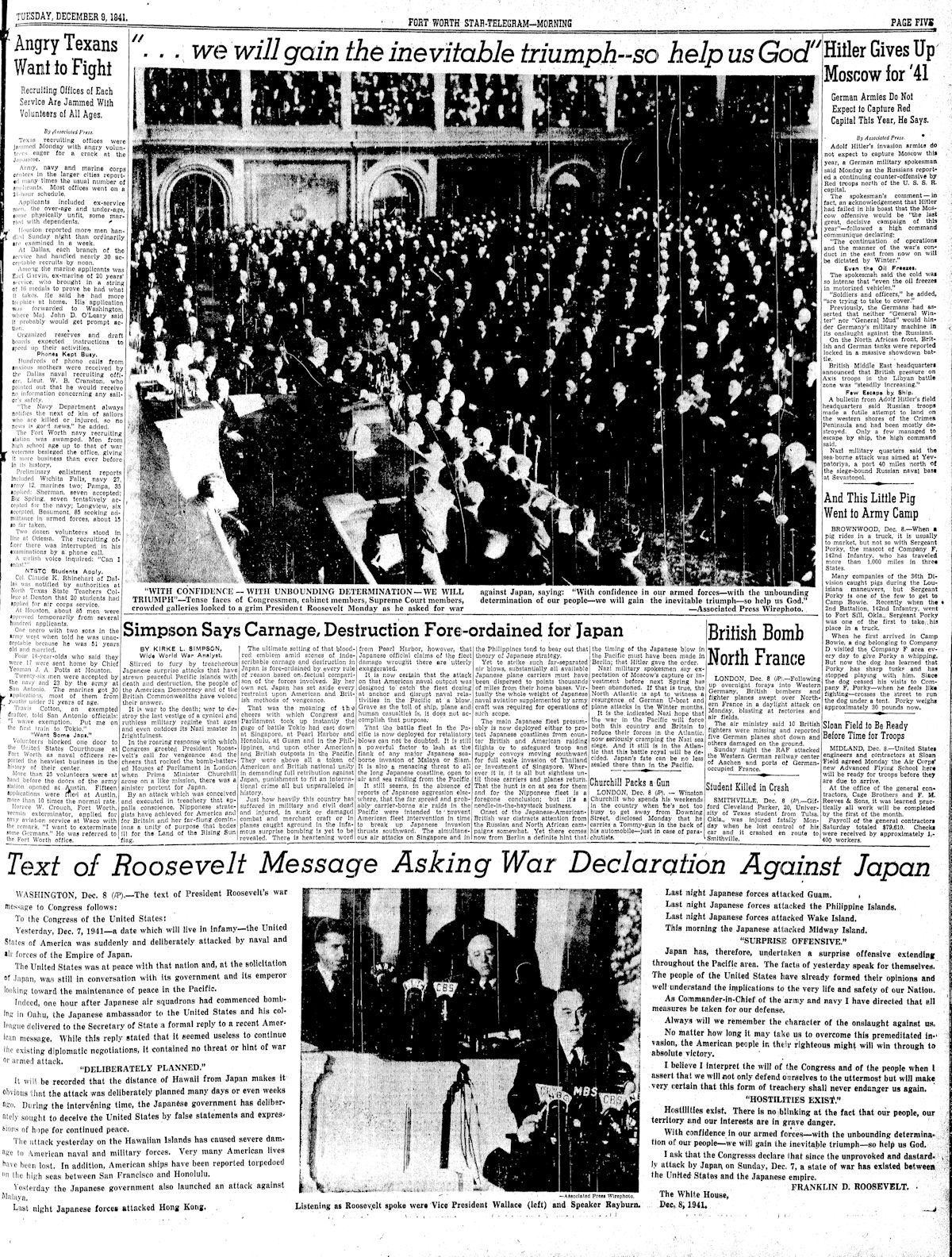 President Roosevelt’s address to Congress on December 8 was transmitted live over all four major U.S. radio networks. It drew the biggest audience ever measured for an American radio broadcast, with more than 81 percent of homes tuned in.
President Roosevelt’s address to Congress on December 8 was transmitted live over all four major U.S. radio networks. It drew the biggest audience ever measured for an American radio broadcast, with more than 81 percent of homes tuned in.
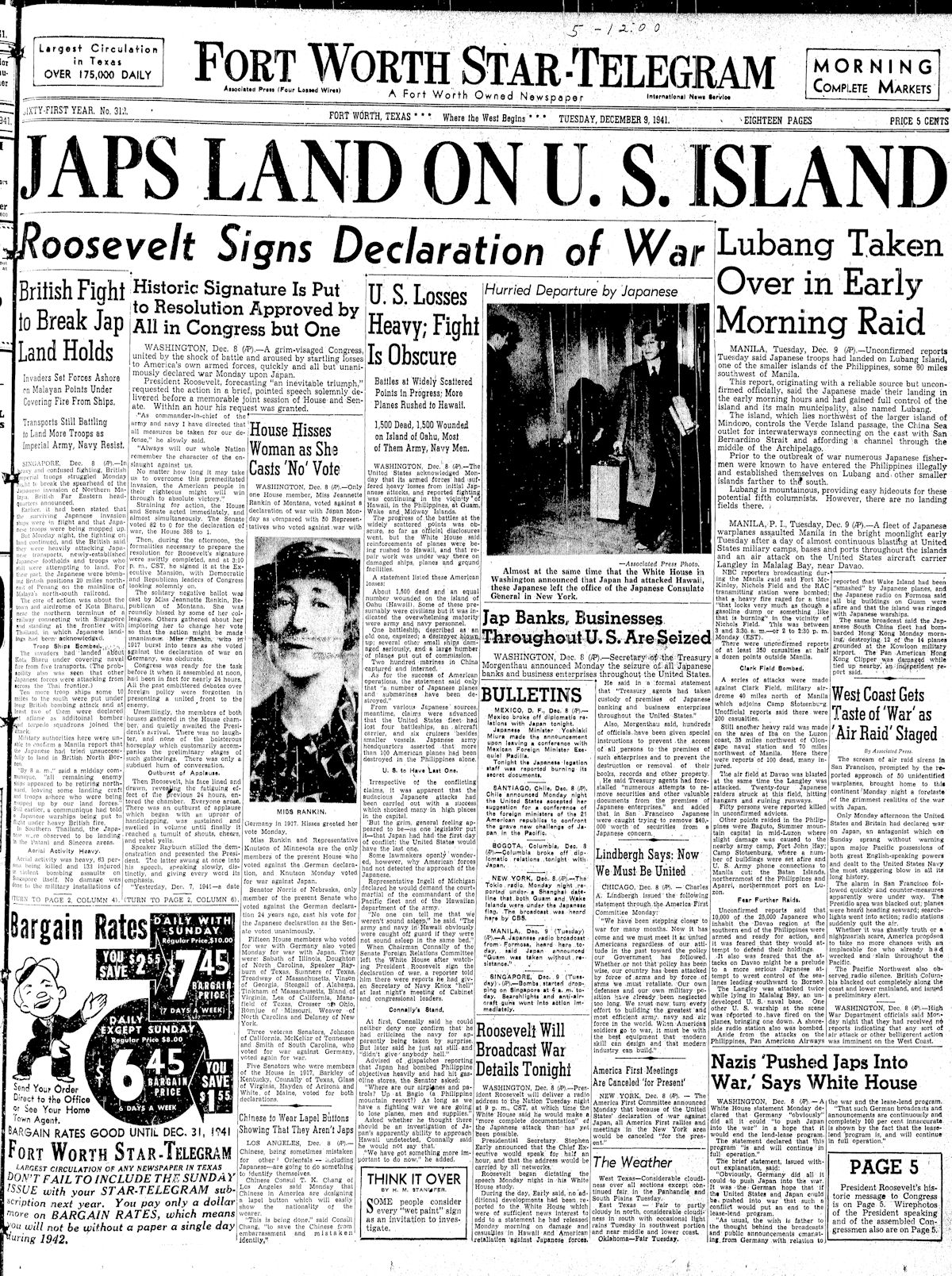
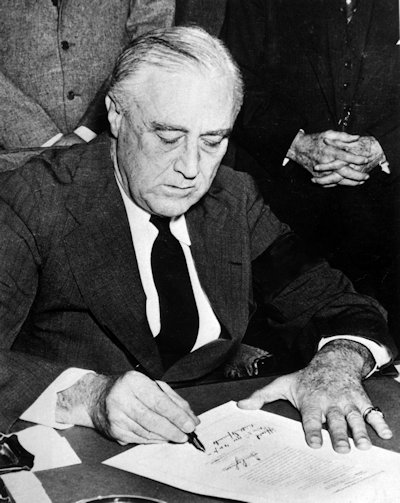 President Roosevelt also signed a war declaration on December 8. (Photo from Wikipedia.)
President Roosevelt also signed a war declaration on December 8. (Photo from Wikipedia.)
Americans would read forty-five months of horrendous headlines (and even-more-horrendous “The secretary of war desires me to express his deep regret that . . .” telegrams) before they read these:
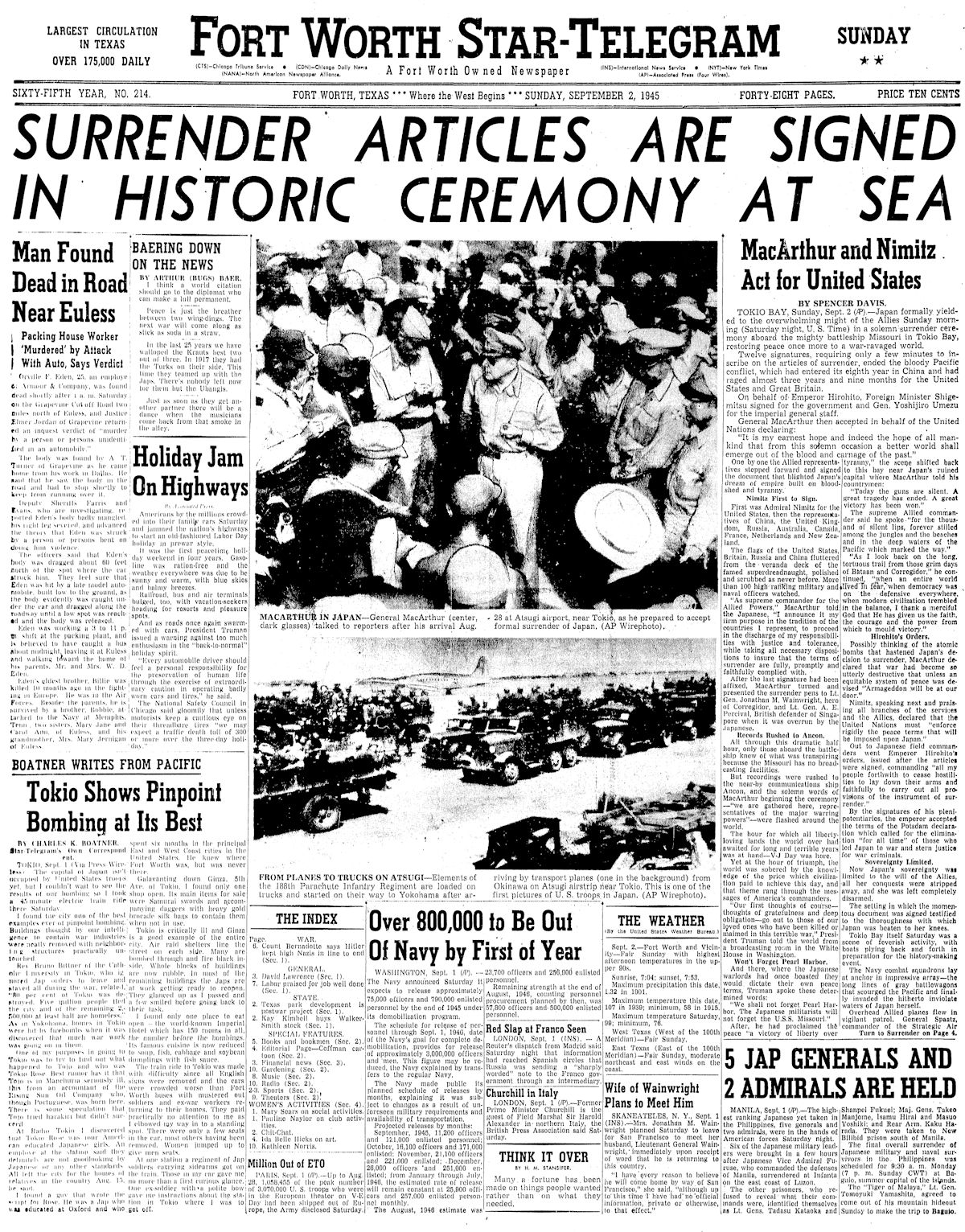
 Worldwide an estimated 70-85 million people died (about 3 percent of the world population of 2.3 billion) in World War II. According to the National WWII Museum, 407,316 Americans were killed and 671,278 wounded.
Worldwide an estimated 70-85 million people died (about 3 percent of the world population of 2.3 billion) in World War II. According to the National WWII Museum, 407,316 Americans were killed and 671,278 wounded.






Thanks again Mike- reading history as it was reported at the time is so informative and eye opening
Thanks, Marian. I agree: Today’s history when it was yesterday’s news is very revealing.
Mikey, Mike, Mike. THANK YOU, thank you, thank you!!! Sunday’s column on songwriter L. Williams was most enjoyable, but I’ve been relishing your return to the paper and can no longer delay sending thanks for history columns and the ones long ago. I recall (saved while raising 5 children including “leftie” oldest) the one about lefthandedness; the one about being a wordnerd or wordsmith is also memorable. Big THANKS for great writing!
Sandra, thank you for giving me my biggest smile of the day.